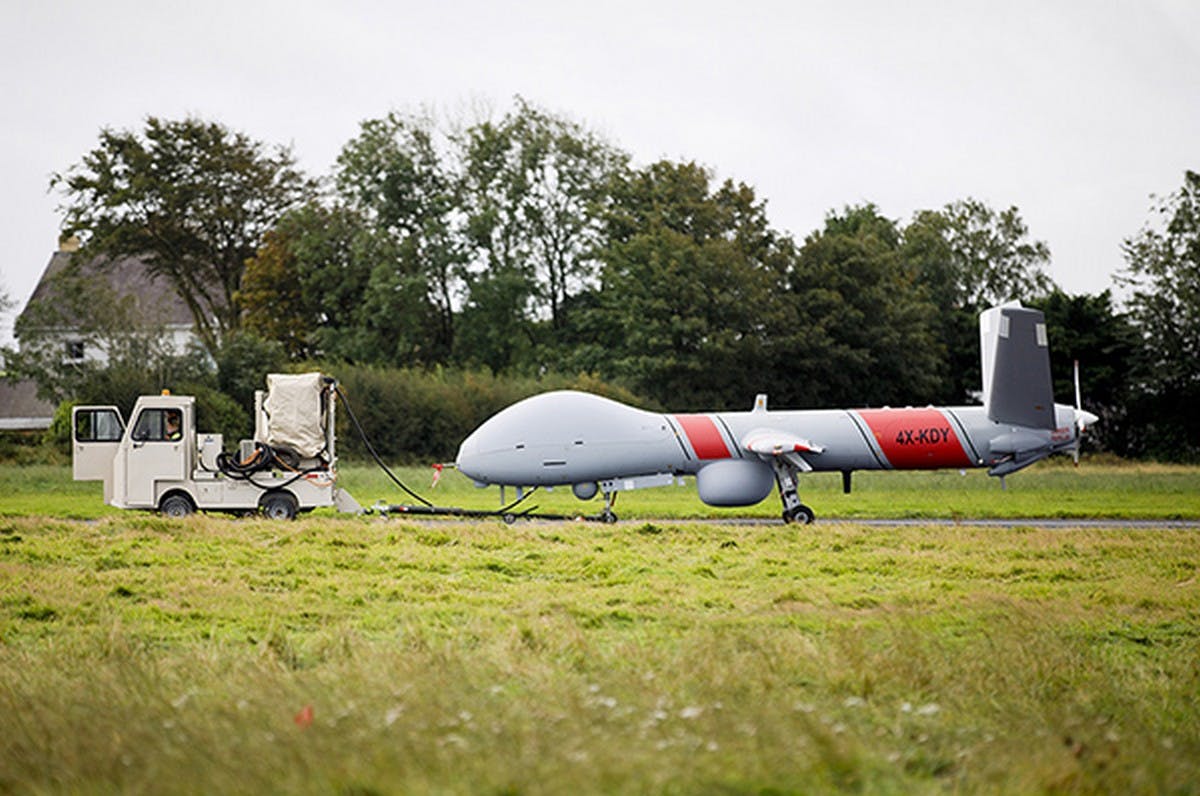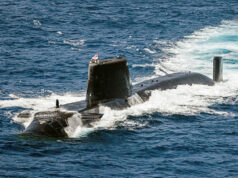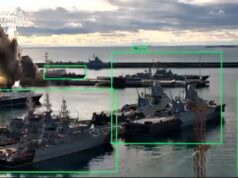An Elbit Systems owned Hermes 900 Unmanned Aerial System has successfully completed a series of flight demonstrations for the Maritime and Coastguard Agency off the coast of the UK.
The demonstrations were run by the MCA and were designed to test the capabilities of using a UAS to enhance Search and Rescue (SaR) capabilities and the use of long-range unmanned capabilities in civilian airspace.
“Taking place off the West Coast of Wales over the first two weeks of September, the Hermes 900 was able to fly advanced Beyond Line of Sight (BLOS) missions into unsegregated and uncontrolled airspace, in full alignment with the UK Civil Aviation Authority (CAA). The success of these trials is a significant step forward in enhancing the capabilities of the MCA as they seek to improve the efficiency and effectiveness of its search and rescue operations while reducing the risk to MCA personnel in the field. Elbit Systems UK is closely collaborating with the UK Civil Aviation Authority, supported by additional UK companies, including Inzpire and Aviation Systems Group.”
In the recent demonstration, the firm say that their Hermes 900 equipped with search and rescue specific radar, an Automatic Identification System (AIS), EO/IR payload, an Emergency Position-Indicating Radio Beacon (EPIRB) and full satellite communications, was deployed on a range of missions that simulated shore-line rescues, water rescues in dangerous air space and long-distance ship rescues which crossed international air space lines.
Martin Fausset, CEO of Elbit Systems UK commented:
“We are pleased to have had the opportunity to showcase our enhanced search and rescue capabilities to the MCA this week. The Hermes 900 is perfectly equipped to deal with the needs of the Maritime and Coastguard Agency and we are proud to be able to support them as they continue with their vital, life-saving work.”
Director of HM Coastguard Claire Hughes said:
“We continue to do all we can to use existing technology as well as look to the future in our ongoing work of saving lives at sea. Remotely piloted aircraft continue to be a big part of that work both to potentially save lives in search and rescue and protect our beautiful coastlines from the worst effects of pollution.”















Why don’t we design and build our own affordable drones to create industries, jobs and supply chains.
BAe developed Mantis over 10 years ago, now were looking at foreign 🙁
https://www.youtube.com/watch?v=D5OvXzUIAkk
yup – absolutely disgraceful what has happened with Mantis and Taranis
we can and should be doing this – but don’t seem to have the strategic will
It was only a tech demonstrator, there was never any plan to buy it, by anyone as far as I can find. Pity, great looking UAV.
I guess that demonstrator never gained enough international interest to take further. I guess it’s difficult to compete with Israel here not only in the technology but perception of excellence because than can over a long period learn and demonstrate their products in a real time active hostile environment. Doesn’t harm I presume being able to access US tech in a more active way than anyone else most of the time.
That said isn’t Watchkeeper one of their designs, only supposedly an improved version and look how problematical that has turned out so maybe it is just perception after all. Funny enough read in last few days a story about increased Israeli/Russian cooperation and drone technology was one of the areas that it suggested Russia would like to tap for its superior electronics knowledge.
“BAe developed Mantis over 10 years ago, now were looking at foreign”
Well, how much developed was it, industrial pipeline, replacements etc? if you want to be serious you need to be permanently investing into the technology/idea.
One offs do not count, sustained use over decades gives a big know how and price advantage.
Israelis sell drones all over world since late 70’s . Not usually know but even to an Arab country like Morocco. So they have a good reputation.
Just nitpicking but Morocco isn’t an Arab country, they’re North Africa.
Well they can be considered since are in that the people that make it are Arabs besides Berbers(the original inhabitants).
Arabs arrived with Islamic conquests.
Now i am well aware that Arab of today is mostly a creation of romantics that Foreign Office used to split the territory of Ottoman Empire.
At time of US lead invasion of Iraqu i remember reading a story about graffitis in Baghdad, many were criticizing the Arabs = Arabs from Arabia, for those that penned the graffiti Arabs were exclusively people from Arabia and not how we call Arabs.
Arab of today is a XIX century term, in fact for practical proposes it replaced what in past were the Moors. Before XIX century Arabs were only people from Arabia.
Thank you Alex, I hope this gets through to people. some people here seems to think of Mantis or Taranis as if it’s a program of record rather than a decade old demo.
We chose not to invest in those programs. Australia has build loyal wingman, which is what these drones would have evolved into in my opinion.
Mantis doesn’t exist, neither does Taranis. We should create an entirely independent drone industry, which is well within our capabilities, if not budget.
The problem is UK leadership. Seems if you don’t do tech you go into politics, the civil service, banking or run a multinational into the ground and sell it offshore!
We really need to do this.
Because the government appears to have higher priorities than defending their country. It’s a disgrace what the government is doing to the military.
Disgrace? really. Modern military equipment is hugely expensive. And we have some of the best. When you see Typhoons and F35’s, and Astute class subs, and 70k tonne aircraft carriers, and P8 Poseidons, do you think ‘what a disgrace’ We build a very large amount of kit that others don’t. Israeli might build drones, but they can’t build a T26, or aircraft carriers, or Nuclear submarines. That negative British attitude, and the ridiculous presumption that ‘everyone else does it better’, is as damaging as anything the MOD might mess up. And our personnel are respected and admired the world over.
“Why don’t we design and build our own affordable drones to create industries, jobs and supply chains.”
“Building stuff” is not anymore incentivized in Western culture.
Look at “news” and what behavior they reward.
Look at structure of incentives in taxes.
Look at increasingly context costs and regulations for everything.
“If it moves, tax it. If it keeps moving, regulate it. And if it stops moving, subsidize it.” Ronald Reagan
Well the Brits do make some of the engines that go into the latest drones. Making an entire drone from the ground up is a very expensive and long process. Easier and a lot cheaper to just buy one off the shelf and then add a few modifications to suit your needs.
Good god. Why aren’t we simply building a fleet of these drones ourselves? Can they be armed with brimstone or hellfire missiles for surface strike?
Could they assist with SAR operations by dropping flares or marker bouys? Or even compact self inflating rescue rafts?
Brimstone for SAR, love it lol, arm it with a huge smoke warhead to guide in the help!
Why not use watchkeeper
Why not just use the maritime version of reaper GA have already demonstrated? could easily be adapted for Protector and infrastructure is pretty much all in place, plus its a much more capable platform.
Because reapers dam expensive. But we will have some old drones knocking about after the new protector drones are delivered.
Regarding this Hermes 900 model which seem much smaller(1100kg) than a Reaper(4500kg) and Heron so eventually cheaper it has been in use in Iceland for ZEE patrol.
From 2019
https://www.naval-technology.com/news/iceland-first-europe-nation-hermes-900-maritime-patrol/
also:
“The European Maritime Safety Agency (EMSA) revealed earlier this month that the Icelandic Coast Guard is using a Hermes 900 UAV for maritime surveillance of its Exclusive Economic Zone (EEZ).
The Hermes 900 is integrated into the existing surveillance mechanisms and procedures covering coast guard functions in the areas of maritime safety and security, search and rescue, environmental protection, law enforcement and fisheries control, the release said.
EMSA added that the Hermes 900 is adapted to withstand the strong winds and icy conditions common to the North Atlantic Ocean. It has an endurance of over 12 hours and may perform maritime surveillance tasks in areas extending as far as 200nm from the shoreline. The operations are based at the Egilsstaðir airport in the east of the island. From there, they have the capability to cover more than half of the Icelandic EEZ.”
The other drone the coastguard have has a 24hr endurance but 100mile range.
What is the model?
It’s nicknames “baby shark” But I can’t remember Its real name, it’s an Austrian company’s drone though. I got the endurance mixed up, it can only stay airborne For 10hrs, and range of 112 miles.
Thanks. Range in drones when they should have a live datalink is mostly related to the radio power not the drone range per se.
What is shocking is that successive Governments and military personnel appear to still think we’re fighting wars in the 90s and have stood still while other countries have raced ahead in unmanned, cyber and missile technologies.
We urgently need to step up and start designing and building drones (E.g. Low, Mid and High-end classes) in the UK. Drone parts would be 3D printed and used between each class where possible.